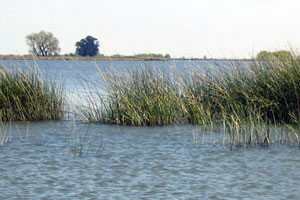
When a humpback whale and her calf took a wrong turn at the Golden Gate Bridge and headed to Sacramento, it drew a lot of eyes (and news media) to the Delta.
But while thousands focused on the plight of the whales, another story was emerging from the Delta-- a story that was, as an editorial in the Sacramento Bee noted, perhaps even more dire despite receiving far less ink. The California Department of Fish and Game released the numbers from its annual spring survey of delta smelt population levels. The trawls from March to May counted only 25 juveniles, the fewest ever recorded and a 92% drop from last year's record low.
I wrote in a recent post about the little delta smelt, a fish native to the Delta and upper San Francisco Bay and considered a key indicator of the health of the ecosystem. Even before these latest dismal numbers, scientists feared the species was on the brink of extinction. Their alarm is, if possible, even greater now. Because smelt live only 1-2 years, the window for the species' recovery is slamming shut fast.
Unlike the humpback, the smelt isn’t the kind of charismatic megafauna that traditionally has grabbed the attention and evoked the sympathies of the broader public (though I think there are several on our staff who would argue the smelt is pretty cute and charismatic in its own right). But whether or not you agree with the Bee's assessment that delta smelt "aren't lovable fish," here is a local species, found nowhere else on the planet, disappearing forever right under our noses. And it is not as if we don't know what to do about it. Scientists have outlined actions that could be taken to help protect the remaining smelt. All we need now is the will to act.
That fact that whales can swim to Sacramento is a vivid reminder that San Francisco Bay is not just a crimp in the Pacific coastline but rather part of elegant interlocking chain linking rivers, Delta, Bay, and ocean. Whales don't normally travel up and down that chain, but lots of other species do: from young Dungeness crab who feed and grow in the Bay's brackish waters before heading for the ocean, to delta smelt who migrate back and forth between the upper Bay and Delta, to salmon who make the entire journey.
